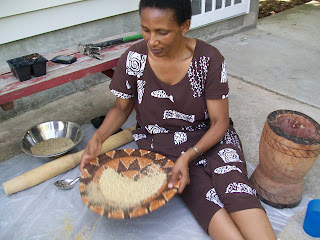A few days back we were taken by surprise. For Mother’s Day Sarah had sent me a 5-gallon bucket of white sorghum grain, the traditional grain of Botswana.
On Thursday, May 12, Betty Mathiba, a friend from Botswana whose husband is studying at Missouri S&T in Rolla, came to our house to show us the proper traditional way to process the grain into a usable flour for porridge. Here is a photo record of the process.
We had brought a kika and motsi (mortar and pestle) from Botswana as part of our artifact collection. This small one was really designed for pounding meat, but the grain pounding one was too large to fit in our shipment back. Betty was resourceful in helping us make this one work.
Betty moistened the four cups of the grain in the mortar with one and a half cups water. The water helped the grain swell slightly to push off the outer shell. She then set to work pounding the grain kernels to crack off the hulls.
The slow and arduous task of pounding the grain was followed by the even more challenging work of winnowing the husks off of the desirable part of the grain.
Betty was able to keep the edible part of the kernel in the basket while making the hulls dance off the edge.
The growing drift of hulls on the floor mat were ideal to save for chicken feed later.
Betty made the grain fly.
Peter tried his hand and after much effort became pretty talented.
The hull-less kernels were then clean and ready to go to the next stage of the grinding or flour making process.
The hull-less grain went back into the kika to be ground into a fine flour for cooking. Betty again put water on the grain to help it swell slightly to be easier in breaking down.
The "thud-thud-thud" of the motsi carried on for a total of 6 hours by the time we got about 8 cups of the grain processed.
We tried to use a metal sieve to speed separating the finer flour form the course chunks, but...
The basket still proved to be the best tool to get the finest and most consistent product.
Finally, we were finished. We had about 3 quarts of bopi jwa mabele or sorghum flour. The following week we had porridge for breakfast. The porridge is made from a starter that takes about 2 days to sour a bit. I have no proof of the effect of the fermentation on the food quality, but I suspect it improved the amino acid formation and mineral/vitamin content. Regardless of the nutrition data, it was delicious! Frankly, I was so excited that I forgot to take pictures to share the final product's appearance. Oh well, I guess I will just have to do it again.













No comments:
Post a Comment